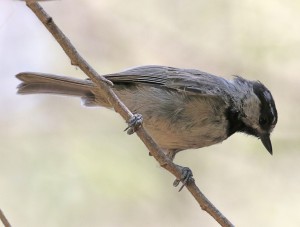The chickadees and titmice of North America belong to a small family (Paridae) without many North American representatives. The Paridae, unlike say warblers, sparrows or woodpeckers, seldom have many members of the family present in the same habitat and locations. For example, southern California, we typically only have one chickadee and one titmouse species in any given area, and some areas have none, since they are generally forest or edge habitat specialists.
Chestnut-backed Chickadees
In southern California, the chickadees are typically much less widespread than the titmice. For chickadees, there are really only two: the Chestnut-backed Chickadee (Poecile rufescens), and the Mountain Chickadee (Poecile gambeli). Chestnut-backed Chickadees occur mainly along the coast, mostly confined to the coastal plain. Look for them from the middle of California up to southern Alaska. In northeastern Oregon, eastern Washington, northern Idaho and southeastern British Columbia, there is a discontinuous range segment more inland. Most authorities recognize three races of Chestnut-backed Chickadee. Generally, the central California race shows the least color, with little to no rufous wash along the flanks. We found this bird among a group of 3-4 at Douglas Family Park on the bluffs above Santa Barbara. The furthest south we’ve ever observed this species.
Mountain Chickadee
The Mountain Chickadees range widely from the Davis Mountains of west Texas across to the coastal plain in San Diego County. They also inhabit much of New Mexico, Arizona, Nevada, Colorado, Wyoming and Montana, and Idaho. In Canada, they live in extreme southwestern Alberta and most of British Columbia, wherever there are mountains. Recently, here in Orange County, our Mountain Chickadees staged a dramatic spread to lower elevations. Surprisingly, several bands of birds apparently breed at nearby Serrano Creek, at well below 2000 feet of elevation. We photographed this particular individual at a more typical location: at over 7000 feet along the Angeles Crest Highway.
Finally, we took these shots with a Canon EOS T3 Rebel camera and a 100-400 mm IS zoom lens.


